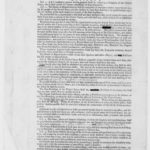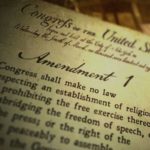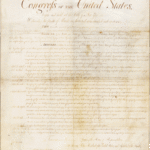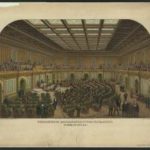Students who listen to this Grade 2 Core Knowledge History and Geography unit discover that Americans had a difficult task at hand after winning the Revolutionary War: they had to figure out a better way to govern themselves. Such leaders as James Madison, George Washington, Alexander Hamilton, and Benjamin Franklin traveled to Philadelphia to meet at the Constitutional Convention, with the goal of creating a new government. Students learn that the talks were held in secret in Independence Hall and that American leaders argued about many issues until they agreed to approve a new Constitution. They then hear that James Madison (whom we call the Father of the Constitution), along with John Jay and Alexander Hamilton, wrote the Federalist Papers to explain the document’s merits and to persuade the states to vote for it. Students find out that the states did finally approve the Constitution; that Madison wrote a Bill of Rights that was added to it; that the Constitution gives the American people the right to decide what the laws should be for our country; and that we can still amend it today.(5 lessons)
Founding Documents: The Constitution Podcast
After just six years under the Articles of Confederation, a committee of anxious delegates agreed to meet in Philadelphia to amend the government. The country was in an economic crisis — citizens couldn’t pay their debts, the government couldn’t really collect taxes, and rebellions were cropping up in states across the nation. The existing government had the potential to drive the country to ruin. So fifty-five men gathered to determine the shape of the new United States.
The document that emerged after that summer of debate was littered with masterful planning, strange ideas and unsavory concessions. The delegates decided they’d be pleased if this new government lasted fifty years. It has been our blueprint for over two centuries now. This is the story of how our Constitution came to be.
This short episode includes a one-page Graphic Organizer for students to take notes on while listening, as well as discussion questions on the back side.
Article VII: Ratification
After months of debate during the hot Philadelphia summer, on September 17, 1787, the Constitutional Convention finally adjourned and the new Constitution was signed, but it was not the law of the land yet. According to Article VII of the document, nine of 13 states would have to ratify (or approve) the new Constitution before it would officially replace the Articles of Confederation as our governing document.
Lesson Plan: How States Redistrict – The Case of 2022
This lesson plan explores the Congressional and state redistricting processes in several states, including Texas, Florida, Colorado, Montana, Oregon, North Carolina, Michigan, Pennsylvania, New York, California, Illinois, Ohio, and West Virginia. The lesson extends to the legislative, executive, and judicial processes as well as the geographic and demographic considerations of redistricting.
The Constitution: Counter Revolution or National Salvation

It is Fall 1787. The Federal Convention has recently concluded its closed door meetings in Philadelphia and presented the nation with a new model for the government. It is now up to each special state convention to decide whether to replace the Articles of Confederation with this new constitution. The debate is passionate and speaks directly to what the founding fathers had in mind in conceiving this new nation. Does this new government represent salvation or downfall?
Freedom of the Press: New York Times v. United States

This documentary examines the First Amendment’s protection of a free press as well as the historic origins of this right and the ramifications of the landmark ruling in New York Times v. United States in which the Supreme Court that prior restraint is unconstitutional. The federal government could not prevent newspapers from publishing the Pentagon Papers. A lesson plan, Defenders of Liberty: The People and the Press, accompanies the video.
The Bill of Rights: Debating the Amendments

In this lesson, students will examine a copy of twelve possible amendments to the United States Constitution as originally sent to the states for their ratification in September of 1789. Students will debate and vote on which of these amendments they would ratify and compare their resulting “Bill of Rights” to the ten amendments ratified by ten states that have since been known by this name.
The U.S. Constitution: Continuity and Change in the Governing of the United States

This unit examines continuity and change in the governing of the United States. Lessons one and two are focused on a study of the Constitution and Bill of Rights and provide access to primary source documents from the Library of Congress. Lesson three investigates important issues which confronted the first Congress and has students examine current congressional debate over similar issues. Lesson four features broadsides from the Continental Congress.
Founding Documents: Federalist and Anti-Federalist Papers Podcast
Ten days after the Constitution was signed at the Old Philadelphia State House, an anonymous op-ed appeared in the New York Journal. Signed by “”Cato,” it cautioned readers of the new Constitution to take it with a grain of salt. Even the wisest of men, it warned, can make mistakes. This launched a public debate that would last months, pitting pro-Constitution Federalists against Constitution-wary Anti-Federalists. It was a battle for ratification, and it resulted in a glimpse into the minds of our Framers – and a concession that would come to define American identity.
Our guides through the minds of the Federalists and Anti-Federalists are Claire Griffin and Cheryl Cook-Kallio.
This short episode includes a one-page Graphic Organizer for students to take notes on while listening, as well as discussion questions on the back side.
The Seneca Falls Convention and the Declaration of Sentiments
The Seneca Falls Convention, held in Seneca Falls, New York, on July 19 to July 20, 1848, was the first women’s rights convention held in the United States. At that convention, the Declaration of Sentiments was written that outlined demands for women’s equality. This lesson uses video clips to have students understand the important people and events that led to the Declaration of Sentiments and then apply the text of the Declaration to today.